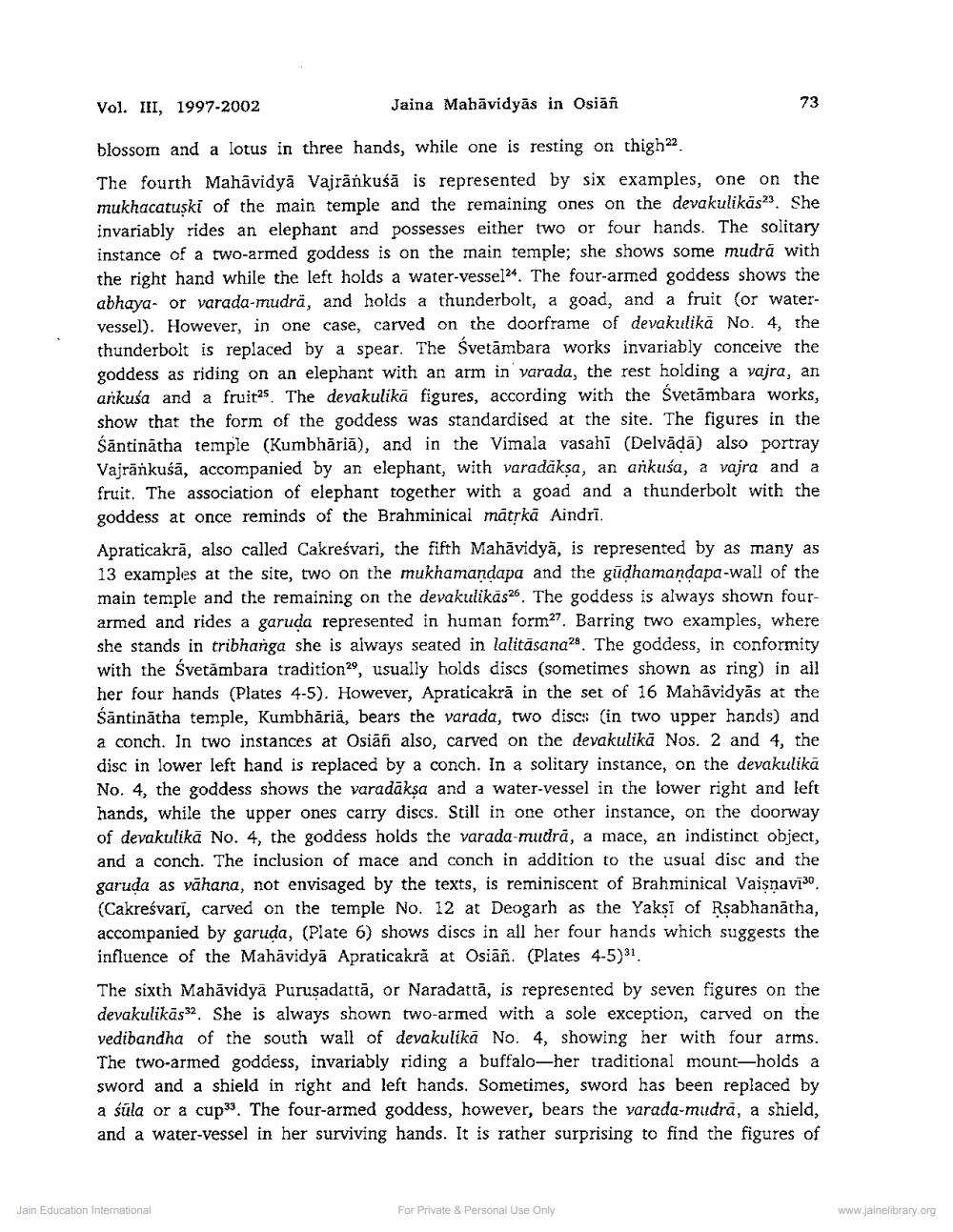Book Title: Jaina Mahavidyas in Osian Author(s): Maruti Nandan Prasad Tiwari, Kamalgiri Publisher: Z_Nirgrantha_1_022701.pdf and Nirgrantha_2_022702.pdf and Nirgrantha_3_022703.pdf View full book textPage 4
________________ Vol. III, 1997-2002 Jaina Mahāvidyās in Osiāñ blossom and a lotus in three hands, while one is resting on thigh. The fourth Mahāvidyā Vajrāńkuśā is represented by six examples, one on the mukhacatuṣki of the main temple and the remaining ones on the devakulikäs. She invariably rides an elephant and possesses either two or four hands. The solitary instance of a two-armed goddess is on the main temple; she shows some mudrá with the right hand while the left holds a water-vessel24. The four-armed goddess shows the abhaya- or varada-mudrä, and holds a thunderbolt, a goad, and a fruit (or watervessel). However, in one case, carved on the doorframe of devakulikā No. 4, the thunderbolt is replaced by a spear. The Śvetāmbara works invariably conceive the goddess as riding on an elephant with an arm in varada, the rest holding a vajra, an ankusa and a fruita. The devakulikā figures, according with the Svetāmbara works, show that the form of the goddess was standardised at the site. The figures in the śāntinātha temple (Kumbhāriā), and in the Vimala vasahi (Delvādā) also portray Vajränkuśā, accompanied by an elephant, with varadaksa, an ankuśa, a vajra and a fruit. The association of elephant together with a goad and a thunderbolt with the goddess at once reminds of the Brahminical matrkā Aindrī. Apraticakrā, also called Cakreśvari, the fifth Mahavidyā, is represented by as many as 13 examples at the site, two on the mukhamandapa and the gūdhamandapa-wall of the main temple and the remaining on the devakulikās26. The goddess is always shown fourarmed and rides a garuda represented in human form27. Barring two examples, where she stands in tribhanga she is always seated in lalitāsana28. The goddess, in conformity with the Svetambara traditiona, usually holds discs (sometimes shown as ring) in all her four hands (Plates 4-5). However, Apraticakrā in the set of 16 Mahāvidyās at the śāntinātha temple, Kumbhāriä, bears the varada, two discs (in two upper hands) and a conch. In two instances at Osiāñ also, carved on the devakulikā Nos. 2 and 4, the disc in lower left hand is replaced by a conch. In a solitary instance, on the devakulika No. 4, the goddess shows the varadākṣa and a water-vessel in the lower right and left hands, while the upper ones carry discs. Still in one other instance, on the doorway of devakulikā No. 4, the goddess holds the varada-mudrā, a mace, an indistinct object, and a conch. The inclusion of mace and conch in addition to the usual disc and the garuda as vāhana, not envisaged by the texts, is reminiscent of Brahminical Vaisnavio (Cakreśvarī, carved on the temple No. 12 at Deogarh as the Yakși of Rsabhanātha, accompanied by garuda, (Plate 6) shows discs in all her four hands which suggests the influence of the Mahavidyā Apraticakră at Osian. (Plates 4-5)31 The sixth Mahāvidya Puruşadattā, or Naradattā, is represented by seven figures on the devakulikās32 She is always shown two-armed with a sole exception, carved on the vedibandha of the south wall of devakulikā No. 4, showing her with four arms. The two-armed goddess, invariably riding a buffalo-her traditional mount-holds a sword and a shield in right and left hands. Sometimes, sword has been replaced by a súla or a cup. The four-armed goddess, however, bears the varada-mudra, a shield, and a water-vessel in her surviving hands. It is rather surprising to find the figures of Jain Education International For Private & Personal Use Only www.jainelibrary.orgPage Navigation
1 2 3 4 5 6 7 8 9 10 11 12 13 14 15 16 17 18 19 20
